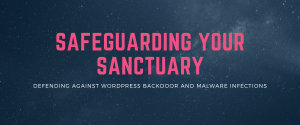This is an overview of common methods attackers use to install malware and backdoors in WordPress installations. Please keep in mind that this information is provided for educational purposes, and it’s important to use this knowledge to secure your website rather than exploit vulnerabilities.
WordPress, the ubiquitous content management system (CMS) which powers a significant portion of the internet. Its popularity, however, makes it an attractive target for malicious actors seeking to exploit vulnerabilities. In this post, we’ll delve into the dark art of how attackers manage to install malware and backdoors within WordPress installations.
It’s worth noting that almost every breached/hacked website we have investigated and cleansed have suffered from multiple of the below methods/examples and always featuring more than 1 backdoor method. We have seen similar code obturated in differing ways in different locations. A website can fall victim to any number of these methods which can also be deployed simultaneously.
Jeopardising the digital fortresses many rely on.
1. Exploiting Vulnerabilities:
One of the most common methods attackers employ is exploiting vulnerabilities in outdated themes, plugins, or even the WordPress core itself. Developers constantly release updates to patch security holes, but neglecting these updates can leave your site exposed. Attackers keenly scan for outdated installations, leveraging known vulnerabilities to gain unauthorised access.
2. Brute Force Attacks:
Attackers often resort to brute force attacks to crack weak passwords and gain entry into WordPress sites. Automated tools tirelessly attempt different username and password combinations until they find the right one. Using strong, unique passwords and implementing two-factor authentication can significantly mitigate the risk of falling victim to brute force attacks.
3. Malicious Plugins and Themes:
The allure of free plugins and themes can be tempting, but sometimes, these come bundled with malicious code. Attackers distribute compromised plugins or themes through unofficial sources, hoping unsuspecting website owners will install them. Always download plugins and themes from reputable sources, and regularly audit your installed extensions for any suspicious activity.
4. Phishing and Social Engineering:
Human vulnerabilities are as exploitable as technical ones. Attackers may employ phishing techniques, sending deceptive emails or messages to trick users into revealing login credentials or clicking on malicious links. Ensuring that users are educated about phishing risks and employing security measures like email verification can mitigate this threat.
5. SQL Injection:
SQL injection involves injecting malicious SQL code into input fields with the aim of manipulating the database. If a WordPress site is not properly sanitised, attackers can exploit this vulnerability to execute arbitrary SQL queries, potentially gaining unauthorised access. Regularly updating WordPress and plugins, and implementing input validation can help protect against SQL injection attacks.
6. Cross-Site Scripting (XSS):
XSS attacks involve injecting malicious scripts into web pages that are then viewed by other users. Attackers often target vulnerabilities in plugins or themes, exploiting them to inject harmful code. To prevent XSS attacks, ensure that your plugins and themes are up-to-date, and employ security mechanisms, such as Content Security Policy (CSP), to mitigate the impact of potential XSS vulnerabilities.
7. File Upload Vulnerabilities:
WordPress allows users to upload files, such as images and documents. However, if not properly configured, this feature can become a gateway for attackers. Malicious actors may upload files containing executable code, leading to the installation of malware or backdoors. Limiting file upload permissions and validating file types can help prevent such vulnerabilities.
8. Backdoors:
Once inside, attackers often install backdoors to maintain persistent access even after the initial breach is discovered and closed. Backdoors can be hidden in various locations, such as modified theme files or disguised as legitimate plugins. Regularly scanning your WordPress installation for unusual files or code and employing security plugins can aid in detecting and removing backdoors.
Conclusion:
Securing a WordPress site requires a multifaceted approach. Regular updates, strong authentication mechanisms, cautious plugin and theme installations, and user education are essential components of a robust defence strategy. By understanding the tactics employed by attackers to infiltrate WordPress installations, website owners can better fortify their digital strongholds against the ever-evolving landscape of cyber threats. Constant vigilance and proactive security measures are the keys to keeping the shadows at bay and ensuring the integrity of your online presence.
In part 3 of this mini spot light series (released later this week), we’ll be looking at tactics for cleansing your website as well as some useful tips on breach prevention, good password and login discipline and what to look out for when selecting your next platform to host your next (or current) WordPress website on.















